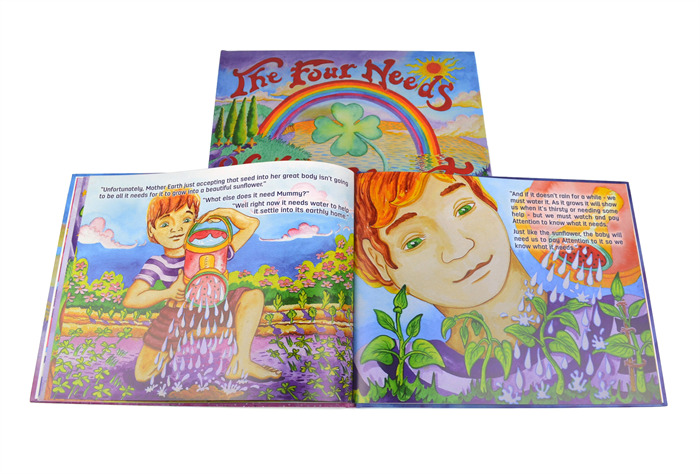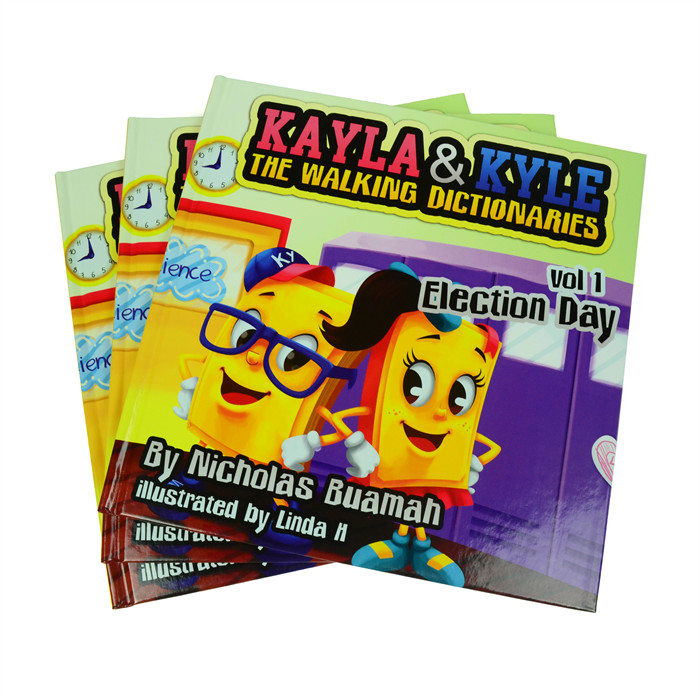Are you plan to custom hardcover children's book printing? There are a few things you'll need to consider before you start the printing process. In this blog post, we'll go over some of the things you need to keep in mind, including the number of pages, the cover design, the type of paper, and the finishing options. We'll also give you some tips on how to prepare your artwork for printing.

How many pages are suitable for hardcover children's book
When you are ready for custom hardcover children's book printing, one of the key considerations is how many pages should be included. Obviously, the page count will have an impact on both the cost and the overall size of the finished book.
So, how many pages are suitable for a hardcover children's book? Well, that really depends on a lot of factors, such as the age of the intended audience, the type of book (e.g., storybook, picture book, activity book, etc.), and so on.
Unlike board book, hardcover almost without page limited. (For the difference between them, click here) Usually, most hardcover children's books will have between 24 and 40 pages. It gives enough space for a decent amount of content without making the book too thick or unwieldy. Of course, there are always exceptions to this rule - some activity books or picture books may have more pages, while shorter stories or poems may be printed on fewer pages.
Ultimately, it is up to the author or publisher to decide how many pages are appropriate for their particular book. However, if you are unsure where to start, a page count of between 24 and 40 is a good place to begin.
The cover design tips of hardcover children's book
Printing a hardcover children's book, the cover design is one of the most important aspects to consider. After all, the cover is what will first catch a potential reader's eye and give them an initial impression of the book.
There are a few key things to keep in mind when designing the cover of a hardcover children's book. First, you need to choose the right cover material. There are a variety of options available, from standard paper to more durable materials, like cardboard, cloth, leather, etc. You'll also need to decide on a finish - for example, whether you want a glossy or matte finish.
Next, you need to think about the size of the book. Hardcover children's books come in a range of sizes, from small pocket-sized books to large format books that are more suitable for older kids. Once you've decided on the size, you'll need to choose an appropriate font and layout for the text on the cover.
Finally, don't forget about any other elements that you may want to include on the cover, such as illustrations or photos. These can really help to make your book stand out from the crowd.
With careful planning and attention to detail, you can create a stunning cover for your hardcover children's book. That will make it impossible for readers to resist picking it up off the shelf.

what's paper is best for hardcover children's book printing
There are a few things to consider when choosing the right paper for hardcover children's book printing. The first is the weight of the paper. A heavier paper will be more durable and will hold up better over time, but it will also be more expensive. Opacity is another important factor to consider when choosing paper for your hardcover children's book. You want to make sure that the text on the pages is easy to read, without any bleed-through from the other side. A more opaque paper will help to prevent this from happening.
Finally, you'll also want to think about the finish of the paper. A glossy finish can make colors pop and images look sharper, but it can also show fingerprints and smudges more easily. A matte finish won't be as shiny, but it can be easier to write on and less likely to show smudges.
Usually, the paper choice depends on your book type. For example, printing children's picture book, this type of book, often less text and much image. To better reproduce color and make the color more vivid, often select glossy coated paper to print on.
Popular finishing for hard cover children's book printing
There are several popular finishes for hardcover children's book printing, including glossy/matte lamination, spot uv, foil stamping, etc. Each has its own benefits and drawbacks, so it's important to choose the right one for your book.
Lamination is a popular finish for hardcover children's books because it provides extra protection against wear and tear. Lamination also makes it easier to clean the book if it gets dirty. Glossy finishes are very popular, because they make the colors pop and give the book a high-quality look. However, they can also be fingerprint magnets, so you'll need to be careful when handling the book. Matte finishes are more understated, but can be difficult to photograph.
Spot UV is also a popular finish for custom hardcover children's books. Spot UV on the certain area of the cover will make its cover more stand out and catch readers eyesight.
Apart from above, foil stamping, varnishing, die cutting, etc. finishes are also popular in printing hardcover children's books.
When choosing a finish for your hardcover children's book. It's important to consider what look you're going for and how the book will be used.
How to decide the quantity for custom hardcover children's book
When deciding on the quantity of hardcover children's books to order, it is important to consider the intended use for the books. Are the books for personal use or for resale? If the books are for personal use, a smaller quantity may be enough. If the books are for resale, a larger quantity may be necessary to meet demand.
It is also important to consider the lead time for printing and shipping when ordering hardcover children's books. Printing a large quantity of books will take longer than printing a small quantity. So it is important to plan ahead and allow enough time for printing and delivery. Rush orders will cost more, but may be necessary if there is a tight deadline.
Besides, it is also important to consider the budget when deciding on the quantity. Printing a large quantity of children's books can be expensive, so it is important to consider how many can be affordably printed.
How to prepare artwork for printing children's books
When preparing artwork for custom children's book printing, it is important to consider the resolution, color mode, and file format. The resolution should be at least 300 dpi, the color mode should be CMYK (cyan, magenta, yellow, and key). Besides, the file format should be a high-resolution PDF.
To make sure that your artwork prints correctly, it is important to follow the guidelines set forth by the printer. Most children's book printers will require that you submit your artwork in a high-resolution PDF format. When creating your PDF, be sure to set the resolution to at least 300 dpi and the color mode to CMYK. It will guarantee that your colors print correctly and that your image is not pixelated when printed.
If you are using images in your artwork, it is also important to consider their resolution. Images should be at least 300 dpi for the best results. If you are using images from the web, be aware that they are typically only 72 dpi and will not print well when enlarged. It is always best to use high-resolution images whenever possible.
Once you have prepared your artwork according to the printer's guidelines, you are ready to submit it for printing. Be sure to proofread your artwork carefully before sending it off so that you can catch any errors or typos. Once your artwork is approved, it will be sent to the printer and made into a beautiful hardcover children's book!
If still no idea to print your own hardcover children's book, or no sure board book VS hardcover: which one is best for your book, please click here, our experts willing to give you some suggestions.

